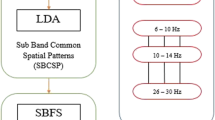Abstract
Stroke is currently known as the third most frequent reason for disability worldwide where the quality of life of its survivors in terms of their daily functioning is seriously affected. Brain-Computer Interface (BCI) is a system that can acquire and transform brain activity into readable outputs. This system is particularly beneficial to the people who encounter physical challenges in carrying out their daily life as the BCI outputs can be applied to BCI-based assistive devices. One of the BCI inputs that are frequently used is the Electrooculography (EOG) signal. EOG signal is the electrical voltage emitted from the movement of our eyeballs. This study aims to extract and identify significant statistical-based time-domain features based on the EOG signals acquired that would facilitate the classification of EOG movements via Support Vector Machine (SVM). The EOG signals were obtained via BioRadio. Five healthy subjects that ranged between 22 and 30 years old were involved in the EOG data acquisition. A total of 7 statistical time-domain features, namely, mean, standard deviation, variance, median, minimum, maximum, and standard error mean were extracted from all four BioRadio channels. The Mutual Information (MI) feature selection technique was employed to identify significant features. The 70:30 hold-out cross-validation technique was used in the study. It was demonstrated from the present investigation that an excellent comparable classification on both train and test dataset is attainable even by utilising the identified features. The findings further suggest the possible application of neurorehabilitation owing to the reduced computational expense resulting from the reduced feature set.
Access this chapter
Tax calculation will be finalised at checkout
Purchases are for personal use only
Similar content being viewed by others
References
Ab Patar MNA, Said AF, Mahmud J, Majeed APPA, Razman MA System integration and control of dynamic ankle foot orthosis for lower limb rehabilitation. In: International symposium on technology management and emerging technologies (ISTMET). IEEE, pp 82–85
Hung LC, Sung SF, Hsieh CY, Hu YH, Lin HJ, Chen YW, Yang YHK, Lin SJ (2017) Validation of a novel claims-based stroke severity index in patients with intracerebral hemorrhage. J Epidemiol 27:24–29. https://doi.org/10.1016/j.je.2016.08.003
Zhang J, Wang B, Zhang C, Xiao Y, Wang MY (2019) An EEG/EMG/EOG-based multimodal human-machine interface to real-time control of a soft robot hand. Front Neurorobot 13. https://doi.org/10.3389/fnbot.2019.00007
Fisher BE, Sullivan KJ (2001) Activity-dependent factors affecting poststroke functional outcomes. Top Stroke Rehabil 8:31–44. https://doi.org/10.1310/B3JD-NML4-V1FB-5YHG
Schaechter JD (2004) Motor rehabilitation and brain plasticity after hemiparetic stroke. Prog Neurobiol 73:61–72. https://doi.org/10.1016/j.pneurobio.2004.04.001
Khairuddin IM, Na’im Sidek S, Majeed APPA, Puzi AA (2019) Classifying motion intention from EMG signal: a k-NN approach. In: 2019 7th international conference on mechatronics engineering (ICOM). IEEE, pp 1–4
McFarland DJ, Wolpaw JR (2011) Brain-computer interfaces for communication and control. Commun ACM 54:60–66. https://doi.org/10.1145/1941487.1941506
Dipietro L, Ferraro M, Palazzolo JJ, Krebs HI, Volpe BT, Hogan N (2005) Customized interactive robotic treatment for stroke: EMG-triggered therapy. IEEE Trans Neural Syst Rehabil Eng 13:325–334. https://doi.org/10.1109/TNSRE.2005.850423
Vahdani-Manaf N (2017) Classification of eye movement signals using electrooculography in order to device controlling. In: 2017 IEEE 4th international conference on knowledge-based engineering and innovation (KBEI). IEEE, pp 339–342
Gray V, Rice CL, Garland SJ (2012) Factors that influence muscle weakness following stroke and their clinical implications: a critical review. Physiother Canada 64:415–426. https://doi.org/10.3138/ptc.2011-03
Lum PS, Godfrey SB, Brokaw EB, Holley RJ, Nichols D (2012) Robotic approaches for rehabilitation of hand function after stroke. Am J Phys Med Rehabil 91:242–254. https://doi.org/10.1097/PHM.0b013e31826bcedb
Rashid M, Sulaiman N, Mustafa M, Bari BS, Sadeque MG, Hasan MJ (2020) Wink based facial expression classification using machine learning approach. SN Appl Sci 2:183
Letchumy J, Rashid M, Musa RM The classification of wink-based EEG signals : the identification of significant time-domain. Springer, Singapore. https://doi.org/10.1007/978-981-15-7309-5
Acknowledgements
The authors would like to acknowledge University Malaysia Pahang for funding this study via RDU180321.
Author information
Authors and Affiliations
Corresponding author
Editor information
Editors and Affiliations
Rights and permissions
Copyright information
© 2022 The Author(s), under exclusive license to Springer Nature Singapore Pte Ltd.
About this paper
Cite this paper
Hwa, P.J. et al. (2022). The Classification of Electrooculography Signals: A Significant Feature Identification via Mutual Information. In: Ab. Nasir, A.F., Ibrahim, A.N., Ishak, I., Mat Yahya, N., Zakaria, M.A., P. P. Abdul Majeed, A. (eds) Recent Trends in Mechatronics Towards Industry 4.0. Lecture Notes in Electrical Engineering, vol 730. Springer, Singapore. https://doi.org/10.1007/978-981-33-4597-3_92
Download citation
DOI: https://doi.org/10.1007/978-981-33-4597-3_92
Published:
Publisher Name: Springer, Singapore
Print ISBN: 978-981-33-4596-6
Online ISBN: 978-981-33-4597-3
eBook Packages: Intelligent Technologies and RoboticsIntelligent Technologies and Robotics (R0)




